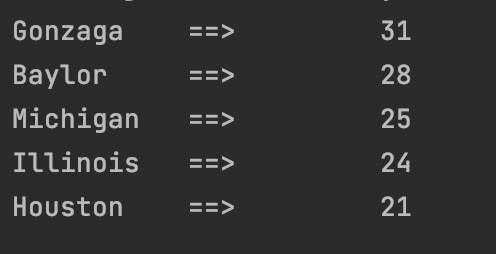In Python, you have a few options to format your strings. In this article, I will go over str.format(), formatted string literals, and template strings.
But first, let's take a look at what is considered to be the "old way" of formatting strings.
What is % string formatting in Python?
One of the older ways to format strings in Python was to use the % operator.
Here is the basic syntax:
"This is a string %s" % "string value goes here"
You can create strings and use %s inside that string which acts like a placeholder. Then you can write % followed be the actual string value you want to use.
Here is a basic example using % string formatting.
print("Hi, my name is %s" % "Jessica")

This method is often referred to as the "older" way because Python 3 introduced str.format() along with formatted string literals.
What is the str.format() method in Python?
Here is the basic syntax for the str.format() method:
"template string {}".format(arguments)
Inside the template string, we can use {} which act as placeholders for the arguments. The arguments are values that will be displayed in the string.
In this example, we want to print "Hello, my name is Jessica. I am a musician turned programmer."
In the string, we are going to have a total of three {} which will act as placeholders for the values of Jessica, musician, and programmer. These are called format fields.
"Hello, my name is {}. I am a {} turned {}."
Inside these parenthesis for the str.format(), we will use the values of "Jessica", "musician", and "programmer".
.format("Jessica", "musician", "programmer")
Here is the complete code and printed sentence:
print("Hello, my name is {}. I am a {} turned {}.".format("Jessica", "musician", "programmer"))

Positional arguments
You can access the value of these arguments using an index number inside the {}.
In this example, we have two arguments of "trumpet" and "drums" inside the .format().
.format("trumpet", "drums")
We can access those values inside the string by referring to the index numbers. {0} refers to the first argument of "trumpet" and {1} refers to the second argument of "drums".
"Steve plays {0} and {1}."
Here is the complete code and printed sentence:
print("Steve plays {0} and {1}.".format("trumpet", "drums"))

We can modify this example and switch the index numbers in the string. You will notice that the sentence has changed and the placement of the arguments is switched.
print("Steve plays {1} and {0}.".format("trumpet", "drums"))

Keyword arguments
These arguments consist of a key value pair. We can access the value of the argument by using the key inside the {}.
In this example, we have two keys called organization and adjective. We are going to use those keys inside the string.
"{organization} is {adjective}!"
Inside the .format(), we have the key value pairs.
.format(organization="freeCodeCamp", adjective="awesome")
Here is the complete code and printed sentence.
print("{organization} is {adjective}!".format(organization="freeCodeCamp", adjective="awesome"))

How to Mix Keyword and Positional arguments
In the str.format() you can mix keyword and positional arguments.
In this example, we are going to create a short story about going to Disneyland.
We are first going to create a few variables for name, number, adjective and a Disneyland ride.
name = "Sam"
adjective = "amazing"
number = 200
disney_ride = "Space Mountain"
We then want to create our string using keyword and positional arguments. I am going to add the \n to tell the computer to create a new line after each sentence.
"I went to {0} with {name}.\nIt was {adjective}.\nWe waited for {hours} hours to ride {ride}."
Inside the parenthesis for the str.format(), we will assign our variables to the keys of name, adjective, hours and disney_ride. {0} will have the value of "Disneyland".
.format("Disneyland", name=name, adjective=adjective, hours=number, ride=disney_ride)
Here is the complete code and printed sentence:
name = "Sam"
adjective = "amazing"
number = 200
disney_ride = "Space Mountain"
print("I went to {0} with {name}.\nIt was {adjective}.\nWe waited for {hours} hours to ride {ride}."
.format("Disneyland", name=name, adjective=adjective, hours=number, ride=disney_ride))

What are formatted string literals?
Formatted string literals (or f-strings) allow you to include expressions inside your strings. Just before the string you place an f or F which tells the computer you want to use an f-string.
Here is the basic syntax:
variable = "some value"
f"this is a string {variable}"
Here is a basic example that prints the sentence Maria and Jessica have been friends since grade school.
name = "Jessica"
print(f"Maria and {name} have been friends since grade school.")
It works just the same if I use a capital F before the string.
name = "Jessica"
print(F"Maria and {name} have been friends since grade school.")

You can also use an f-string to format data from a dictionary.
In this example, we have a dictionary which represents the top rankings for men's college basketball teams and how many games they won out of 32.
rankings = {"Gonzaga": 31, "Baylor": 28, "Michigan": 25, "Illinois": 24, "Houston": 21}
We can use a for loop and the items() method to go through each of the key value pairs of the rankings dictionary.
for team, score in rankings.items():
Inside the for loop, we can use an f-string to format the printed results.
The use of the : for {team:10} and {score:10d} tells the computer to create a field that is 10 characters wide. This will create even columns for the data.
The d inside here {score:10d} refers to a decimal integer.
print(f"{team:10} ==> {score:10d}")
Here is the full code and the printed output:
rankings = {"Gonzaga": 31, "Baylor": 28, "Michigan": 25, "Illinois": 24, "Houston": 21}
for team, score in rankings.items():
print(f"{team:10} ==> {score:10d}")

What are template strings?
Template strings are Python strings that use placeholders for the real values.
Here is the basic syntax:
Template("$placeholder").substitute(placeholder="real value")
Let's take a look at an example to better understand how it works.
In this example, we want to print I love to learn with freeCodeCamp! using template strings.
In order to use template strings, you will first have to import the Template class from the standard library.
from string import Template
You can then use the Template class and provide a string inside the parenthesis. We are going to place a $ in front of name which will later be replaced by the real value.
Template("I love to learn with $name!")
We then add .substitute to the template and assign the value of freeCodeCamp to name.
.substitute(name="freeCodeCamp")
Here is the full code and the printed output:
from string import Template
print(Template("I love to learn with $name!").substitute(name="freeCodeCamp"))

Conclusion
There are many ways to format your strings in Python.
The older way of formatting your strings would be to use the % operator.
"This is a string %s" % "string value goes here"
%s acts as a placeholder for the real value. You place the real value after the % operator.
This method is often referred to as the "older" way because Python 3 introduced str.format() and formatted string literals (f-strings).
In the str.format() method, you use {} for placeholders and place the real values inside the parenthesis. This method can take in positional and keyword arguments.
"template string {}".format(arguments)
Formatted string literals (or f-strings) allow you to include expressions inside your strings. Just before the string you place an f or F which tells the computer you want to use an f-string.
variable = "some value"
f"this is a string {variable}"
You can also use Template strings by importing the Template class from the standard library. Template strings are Python strings that use placeholders for the real values.
Template("$placeholder").substitute(placeholder="real value")
I hope you found this article helpful and best of luck on your Python journey.

